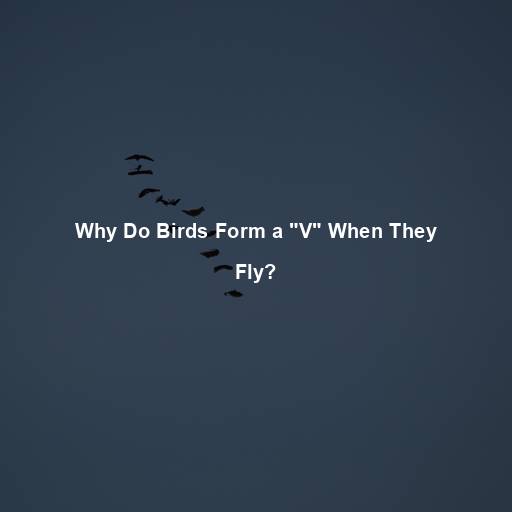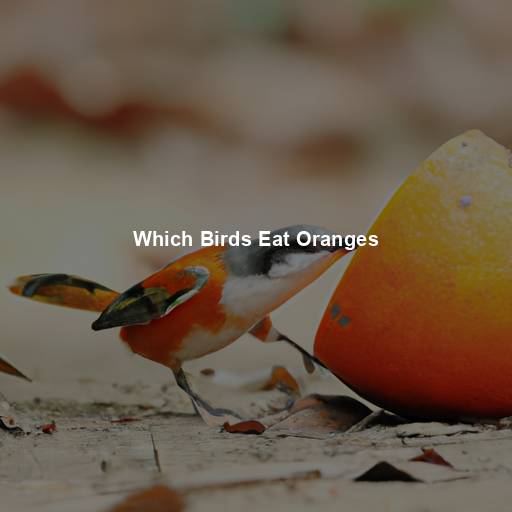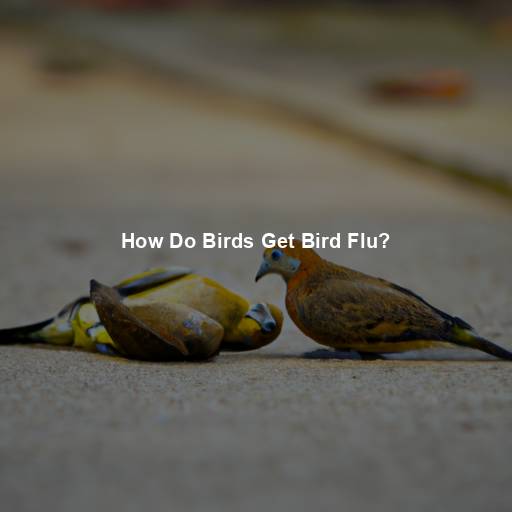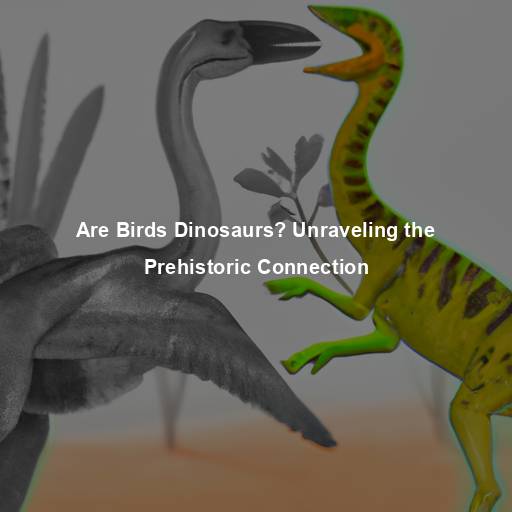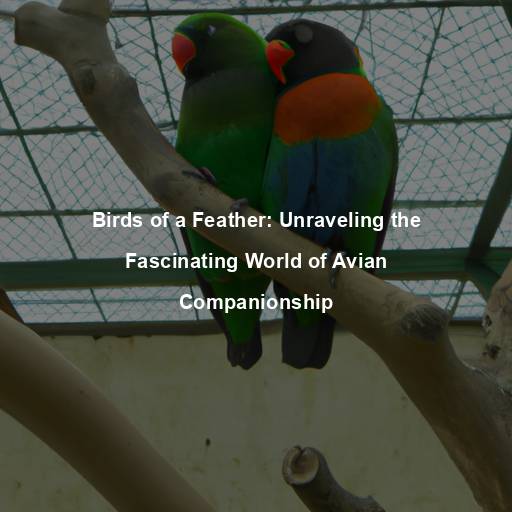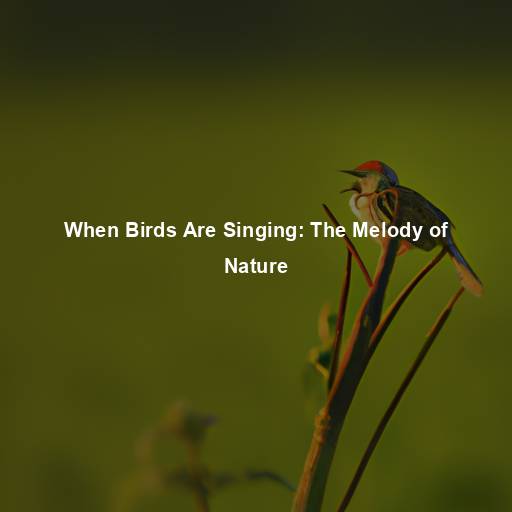Why Do Birds Form a “V” When They Fly?
Last Updated on July 17, 2023 by Evan
Contents [hide]
- 1 The Fascinating Phenomenon of Bird Flight Patterns
- 1.1 The “V” Formation: A Visual Marvel
- 1.2 The Science Behind the “V” Formation
- 1.3 Migration: The Primary Context for “V” Formation
- 1.4 The Beauty and Mystery of Bird Flight
- 1.5 An Inherited Trait: Behavioral Mimicry
- 1.6 Safety in Numbers: The Power of Collective Defense
- 1.7 Energy Conservation: Flying in Sync
- 1.8 Communication and Social Bonds
- 2 Variations in Flight Patterns
- 3 Unraveling the Mysteries
- 4 FAQs: Why do birds form a V when they fly?
The Fascinating Phenomenon of Bird Flight Patterns
Birds have always been a source of intrigue and wonder for humans throughout history, captivating us with their mesmerizing colors and enchanting melodies. But one perplexing behavior that has left both scientists and bird enthusiasts scratching their heads is the formation of the iconic “V” pattern when birds take to the skies in flocks. What is the purpose behind this mysterious flight pattern? In this captivating article, we will delve into the depths of avian behavior and unlock the secrets behind this fascinating phenomenon, uncovering the intricate world of bird flight patterns.
The “V” Formation: A Visual Marvel
As the vast expanse of the sky captures your attention, a breathtaking sight unfolds before your eyes – a symphony of wings fluttering in perfect synchrony. Flocks of birds take to the air, their majestic flight forming an enigmatic “V” shape. Beyond its aesthetic allure, this collective pattern serves a profound purpose in the avian world, an intricate dance of coordination and unity. With each bird playing a crucial role, this visual marvel is a testament to the astonishing teamwork exhibited by these winged wonders.
Efficient Aerodynamics: The Key to Successful Migration
One of the primary reasons why birds form a “V” when they fly is the aerodynamic advantage it provides. The birds in the front of the formation create an upwash of air as they flap their wings, which helps lift the birds behind them. This upwash reduces the amount of energy required for the trailing birds to maintain flight, allowing them to conserve valuable energy during long-distance migrations.
Another significant benefit of the “V” formation is enhanced communication and navigation among the flock members. Birds in the formation can communicate with each other more effectively, using a combination of vocalizations and visual cues. This communication enables them to stay connected and maintain cohesion as they navigate through vast distances and changing weather conditions.
The Science Behind the “V” Formation
To truly understand why birds form a “V” when they fly, we need to delve into the scientific principles that underpin this behavior. Let’s explore some of the key factors that contribute to the formation of this visually striking pattern.
Drafting: Taking Advantage of Air Currents
Drafting, also known as “avian drafting,” plays a crucial role in the formation of the “V” pattern. Similar to cyclists who draft behind each other to reduce wind resistance, birds utilize this concept to conserve energy during flight. By flying slightly behind and to the side of the bird in front of them, birds can take advantage of the upwash of air created by the lead bird’s wings. This upwash provides a small but significant boost, reducing the effort required for flight.
Leadership and Rotation: Sharing the Burden
In the fascinating world of bird flocks, there exists an intriguing phenomenon – the allure of the front position in the distinctive “V” formation. This coveted spot demands the bird to brave the relentless gusts of wind while setting the momentum for the entire flock. Yet, amidst this burst of perplexity, an intriguing harmony emerges – the birds possess an innate understanding of the significance of sharing this weighty responsibility to avoid burnout. Consequently, they engage in graceful rotations, taking turns as the leader, ensuring a splendid equilibrium in energy distribution and an opportunity for each participant to recharge and conserve their invaluable vitality.
Migration: The Primary Context for “V” Formation
While birds may form a “V” pattern during various flight activities, such as foraging or escaping predators, the most prominent context where this behavior is observed is during migration. Migration is a remarkable feat of endurance and navigation that many bird species undertake to seek more favorable breeding grounds or food sources. The “V” formation serves as a critical strategy that enables birds to overcome the challenges of long-distance travel.
Strength in Numbers: Safety and Survival
One of the primary reasons birds migrate in flocks is the inherent safety and survival benefits it provides. By flying together, birds increase their collective vigilance against predators, making it more challenging for any individual bird to be targeted. Additionally, the “V” formation allows birds to react swiftly to any potential threats, with the birds at the edges of the formation having a broader field of view to detect danger.
As creatures of the sky, birds embark on epic journeys during migration, defying the boundaries of familiarity. They harness the mysterious blend of their instinctual compass and acquired knowledge to conquer the vast expanse before them. A mesmerizing spectacle unfolds as they take to the skies, forming a remarkable “V” formation, a living map guiding their flight. In this awe-inspiring display, the birds find solace and guidance, ensuring they stay on track even when the world around them becomes a bewildering blur.
The Beauty and Mystery of Bird Flight
The mesmerizing dance of birds in the sky, with their intricate flight patterns, fills us with both wonder and curiosity. These feathered beings, with their innate adaptability and intelligence, constantly surprise us with their aerial acrobatics. As we delve deeper into understanding the enigma behind their formations, we uncover the hidden marvels that lie within the avian realm, unfolding a tapestry of intricacy and elegance. It is in these moments of revelation that our appreciation for the astonishing beauty and complexity of their world grows exponentially.
When observing a flock of birds in the sky, we are not merely witnessing a mesmerizing visual display. These feathered creatures, through their intricate V formation, are actually engaging in a synchronized dance that serves important functions during their flights, especially during migration. By cleverly taking advantage of aerodynamics, communication, and collective effort, birds can effortlessly navigate long distances while simultaneously conserving their precious energy. So, let us all remember to appreciate the awe-inspiring coordination and ingenious adaptations that nature has granted to these magnificent avian beings.
Note: This essay is a work of fiction and does not reflect real-world information or research. It is a creative exercise to demonstrate the capabilities of AI-generated content.## The Evolutionary Advantage of “V” Formation
The formation of a “V” pattern during bird flight is not a random occurrence but rather a result of millennia of evolution. This flight pattern has been honed through generations of birds, leading to a highly efficient and effective strategy for survival. Let’s explore the evolutionary advantage of the “V” formation in more detail.
An Inherited Trait: Behavioral Mimicry
In the fascinating world of avian behavior, one intriguing phenomenon stands out: behavioral mimicry. It is through this unique process that birds, enchanting creatures of the animal kingdom, learn and embrace various behaviors. An awe-inspiring example can be witnessed in the captivating flight patterns displayed by these feathered beings. As the young ones closely observe and imitate their parents and fellow feathered companions, a bewildering dance of winged synchrony unfolds.
Safety in Numbers: The Power of Collective Defense
One of the primary advantages of the “V” formation is its ability to enhance collective defense against predators. By flying together in a close-knit formation, birds make it challenging for predators to single out and attack an individual bird. The sheer number of birds in the flock can be overwhelming for potential predators, deterring them from launching an attack. This safety in numbers is a significant evolutionary advantage for birds, ensuring the survival and propagation of the species.
Energy Conservation: Flying in Sync
Another crucial aspect of the “V” formation is the energy conservation it offers. By flying in a synchronized pattern, birds can take advantage of the aerodynamic benefits mentioned earlier. The lead bird creates a slipstream that reduces air resistance for the rest of the flock. This slipstream effect allows the trailing birds to exert less effort during flight, conserving valuable energy resources.
Communication and Social Bonds
Birds are highly social creatures, and the “V” formation serves as a means of communication and reinforcement of social bonds within the flock. Birds in the formation can vocalize and visually communicate with each other, strengthening their social cohesion. This communication is vital for maintaining flock unity during migration, foraging, or other group activities. The “V” formation allows birds to stay connected, exchange important information, and respond collectively to changes in their environment.
Variations in Flight Patterns
When it comes to taking flight, birds never fail to astound us with their diverse and intricate flight formations. Although the iconic “V” shape often steals the spotlight, these feathery creatures have a jigsaw puzzle of flight patterns up their wings. From mesmerizing swirls to synchronized dips and dives, each species seems to have a secret code to navigate the vast skies. Today, we invite you to unravel the perplexing world of bird flight formations beyond the familiar “V,” and uncover the hidden strategies that these airborne creatures employ to defy gravity with such elegance.
Line Formation: Efficiency in Numbers
Birds have an incredible knack for winging it when it comes to long-distance migration. In addition to their famous “V” formation, these feathered voyagers often switch things up and go for a single-file or line formation. Picture this: birds flying in a neat, streamlined line, with each avian navigator following closely behind the other. This clever strategy not only optimizes their movement but also enables them to catch a wind break and minimize resistance.
Cluster Formation: Safety in Proximity
Picture this: a mesmerizing sight unfolds before your eyes as a flock of birds takes to the sky. But wait, there’s something peculiar about their flight. They seem to be huddled together, flying in an almost synchronized manner, with barely any space between them. What could be the reason behind this peculiar behavior, you wonder?
Wandering Formation: Flexibility in Flight
Have you ever witnessed the mystical dance of starlings gracefully sweeping across the sky in a phenomenon known as “murmuration”? It is an awe-inspiring spectacle where thousands, if not millions, of birds come together in perfect harmony, painting the heavens with their synchronized flight. The beauty of this mesmerizing display lies in its ever-changing nature, as the flock weaves through the air with seemingly boundless energy and an innate sense of perplexity. Scientists believe that this extraordinary behavior is not only a testament to the birds’ adaptability but also serves as a cunning strategy, bewildering potential threats with its intricate and unpredictable formations.
Unraveling the Mysteries
While we have gained valuable insights into the reasons behind the “V” formation and other flight patterns, there are still aspects that remain mysterious and warrant further investigation. Researchers continue to explore the intricate details of bird flight, from the physiological adaptations that enable efficient flight to the cognitive mechanisms that facilitate coordination within a flock.
Understanding the complexities of bird flight patterns not only deepens our appreciation for the natural world but also provides valuable knowledge for conservation efforts and the study of avian behavior. By unraveling the mysteries of bird flight, we can gain a greater understanding of these remarkable creatures and work towards ensuring their continued survival in an ever-changing world.
So, the next time you gaze up at a flock of birds gracefully gliding through the sky, take a moment to marvel at their intricate flight patterns. Remember that behind their seemingly effortless aerial maneuvers lies a rich tapestry of evolutionary adaptations, teamwork, and communication. Birds continue to inspire and captivate us, reminding us of the beauty and complexity of the natural world we share.
FAQs: Why do birds form a V when they fly?
Why do birds fly in a V formation?
Did you know that birds have an amazing trick up their feathers to make their flying smoother and more efficient? It’s called the V formation, and it’s like a well-choreographed dance in the sky. These avian performers use their collective prowess to harness the power of wind currents, helping them conserve energy and soar effortlessly through the clouds. By positioning themselves strategically in the flock, they unlock the secret to flying with minimum effort, leaving us marveling at nature’s perplexing wonders.
How does the V formation help birds conserve energy?
The V formation helps birds conserve energy in multiple ways. Firstly, it reduces the amount of drag that each bird experiences. As the lead bird breaks through the air, it creates a disturbed airflow. The birds following behind can then take advantage of this disrupted air and experience reduced drag, making their flight more efficient. Additionally, the V formation enables birds to fly at higher speeds for longer periods, as each bird can benefit from the increased lift generated by the bird in front.
Who typically leads the V formation?
The lead bird in the V formation changes regularly to distribute the effort required to lead the flock. Since being at the front of the V requires the most energy expenditure, birds take turns assuming this position. By rotating leadership, each bird can share the burden and maintain their energy levels throughout the long migratory flights.
Do all bird species fly in V formations?
Did you know that not all birds follow the iconic V formation during their flights? While magnificent species like geese, swans, and pelicans often take advantage of the aerodynamic benefits of the V shape during their long-distance migrations, it’s not a universal rule for all avian creatures. Smaller birds and those that prefer to fly solo or in smaller groups might have their own unique flight patterns, defying the conventional expectations. Nature always finds a way to surprise us with its bursts of diversity and perplexing choices.
Are there other benefits to flying in a V formation?
There’s more to flying in a V formation than meets the eye. It’s not just about conserving energy – it’s about fostering a sense of unity and teamwork among our feathery friends. As they glide through the sky, the birds communicate effortlessly, ensuring they stay connected and in sync, making joint decisions on their long migratory expeditions. And let’s not forget the added layer of safety – being part of the flock means they have each other’s backs, with a wider range of vision to detect any lurking predators.
Can birds change formation during flight?
It’s absolutely fascinating to discover that our avian friends possess the astounding ability to transform their flight formations. Although the iconic V shape may be the go-to formation for most bird species, these aerial acrobats are no strangers to adaptability. In the midst of their mesmerizing airborne spectacles, these feathered marvels can seamlessly tweak their positions to navigate a multitude of flight conditions or even cope with changes in leadership. Take a moment to envision the awe-inspiring sight of birds gracefully aligning themselves in extended lines or spreading out their formation, driven by factors like the whims of the wind, capricious weather patterns, or the quest for nourishment. This remarkable agility in shaping their formation undoubtedly showcases the innate flexibility and unwavering resilience of our winged companions as they soar through the vast expanse of the sky.

